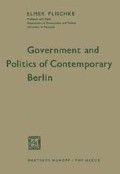Abstract
Under the Constitution of 1950, Berlin has become a German Land (state) — a status it had never enjoyed before.1 In keeping with this change, the Constitution altered the names of the old municipal agencies, so that the Magistrat and Stadtverordnetenversammlung (City Assembly) have become the Senat (Senate) and Abgeordnetenhaus (House of Representatives). The Senat corresponds to the cabinet of ministers in the West German Länder (states) and the Abgeordnetenhaus to the Landtag (state legislature).2
Access this chapter
Tax calculation will be finalised at checkout
Purchases are for personal use only
Preview
Unable to display preview. Download preview PDF.
References
As noted earlier, however, Berlin did not thereby become a constituent Land (state) in the Federal Republic of Germany. This question also is discussed more fully below in Chapter 6.
For a graphic depiction of the government of Land Berlin, see accompanying Charts 5 and 6.
The Freedom Bell, one of the largest in the world, peals daily at noon. It is a replica of the “Liberty Bell” in Philadelphia, and on its rim it carries the inscription: “That this world under God shall have a new birth of freedom.”
Magistrat, Abteilung Rechtswesen, Verordnungsblatt für Berlin, Vol. 6, Part I, No. 63, October 6, 1950, pp. 446-457.
For a discussion of the operation of the first Electoral Law, see Elmer Plischke, Berlin: Development of Its Government and Administration (Bad Godesberg/Mehlem, 1952), pp. 88-90.
See Elmer Plischke, Contemporary Government of Germany (Boston, 1961), pp. 158, 162–163.
At present, 80 seats in the Abgeordnetenhaus are filled by direct election, and the remaining 53 by proportional representation.
Under the 1949 West German Electoral Law, 60 per cent of the Bundestag seats were filled by direct election and 40 per cent by proportional representation. In 1953 the ratio was changed to 50/50, half of the delegates being elected by each system. See Plischke, Contemporary Government of Germany, op. cit., pp. 161-162.
On the basis of the 1950 and 1954 elections, 127 delegates were elected in West Berlin and 73 seats were reserved for East Berlin; at the time of the election of 1958 the figures were 133 and 67 respectively. Also see Table I below.
For a description of the application of the 5 per cent rule in the West German Federal Republic at both the national and state levels, see Plischke, Contemporary Government of Germany, op. cit., especially pp. 160-161, 172.
The Abgeordnetenhaus is the subject of Articles 25 to 39 of the 1950 Constitution.
See Chart 6.
Initially it was constitutionally required to meet at least once a month, but this specification was changed by constitutional amendment in 1956. Two years later another amendment was adopted requiring the chamber also to be brought into session on the demand of one-fifth of its members or by the Senat.
Constitution of 1950, Article 47.
The early legislative experiences of the Abgeordnetenhaus are described briefly in Plischke, Berlin: Development of Its Government and Administration, op. cit., pp. 95-98.
The Berlin executive is the subject of Articles 40 to 44 of the 1950 Constitution.
For some years there have been 11 or 12 Senators.
The political leaders serving as Regierender Bürgermeister of West Berlin have included Professor Ernst Reuter, Dr. Otto Suhr, and currently Willy Brandt.
Constitution of 1950, Article 42.
The administration of justice is dealt with in Articles 62 to 72 of the 1950 Constitution.
Prior to World War II, Berlin had three Landgerichte whose jurisdiction, however, extended beyond the city limits.
See “Rechtswesen,” Berlin, 1948, Jahresbericht des Magistrats (Berlin, 1949), pp. 39-40; also see Plischke, Contemporary Government of Germany, op. cit., pp. 199-201.
The Bundesgerichtshof is discussed more fully in ibid., pp. 124-125.
Magistrat, Abteilung Rechtswesen, Verordnungsblatt für Berlin, Vol. 7, Part I, No. 3, January 16, 1951; and Der Senator für Justiz, Verordnungsblatt für Berlin, Vol. 7, Part I, No. 12, March 7, 1951.
For a brief description of the West German Administrative Courts, see Plischke, Contemporary Government of Germany, op. cit., pp. 125-127.
The Federal Constitutional Court of West Germany is described in ibid., pp. 127-138.
Article 64 of the Constitution stipulates that “the Courts do not have the right to examine the constitutionality of laws and ordinances enacted by the Abgeordnetenhaus.”
For a graphic depiction of the government of East Berlin, see accompanying Charts 7 and 8.
East Germany was initially composed of five Länder (states), but in 1950 they were reduced to regional sub-elements of the central government, and in 1952 their governments and parliaments were abolished by legislative action. In their place the central government established a hierarchical system comprised of fourteen Bezirke (provinces) — fifteen including East Berlin — each of which contains some fifteen or sixteen Kreise (districts). These East German Bezirke must be distinguished from the Berlin Bezirke, mentioned below. For a description of the state and local government of East Germany, see Plischke, Contemporary Government of Germany, op. cit., p. 188.
The Bezirke are dealt with in Articles 50 to 61 of the 1950 Constitution.
Author information
Authors and Affiliations
Rights and permissions
Copyright information
© 1963 Martinus Nijhoff, The Hague, Netherlands
About this chapter
Cite this chapter
Plischke, E. (1963). Governmental System. In: Government and Politics of Contemporary Berlin. Springer, Dordrecht. https://doi.org/10.1007/978-94-011-9135-7_4
Download citation
DOI: https://doi.org/10.1007/978-94-011-9135-7_4
Publisher Name: Springer, Dordrecht
Print ISBN: 978-94-011-8424-3
Online ISBN: 978-94-011-9135-7
eBook Packages: Springer Book Archive

